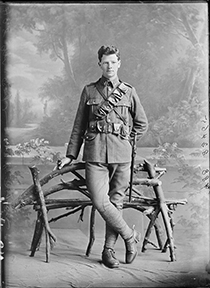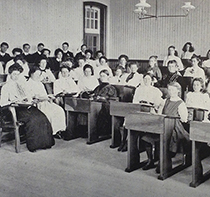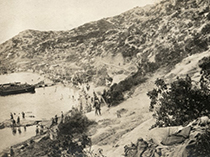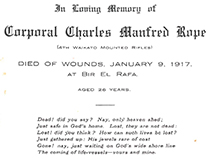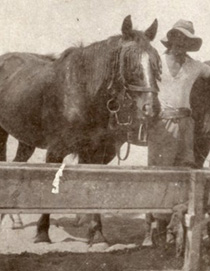
Portable canvas troughs were used to water the horses.Accession No. 1993.1210, Kippenberger Military Archive, National Army Museum Te Mata Toa, Waiouru.
The Sinai and the Anzac Mounted Division
When Rope’s unit reached the Sinai, the flat desert must have seemed a world away from the raging guns and mud of Gallipoli and after living in close quarters, this battlefield must have seemed empty. Their primary job was to build, develop and protect supply lines, including a railroad, to support the second wave of troops which would join them for a larger push toward Palestine. The work was made harder by the heat, which some complained was worse than Cairo. Also, the local water supply was foul tasting and not popular among the men or the horses.
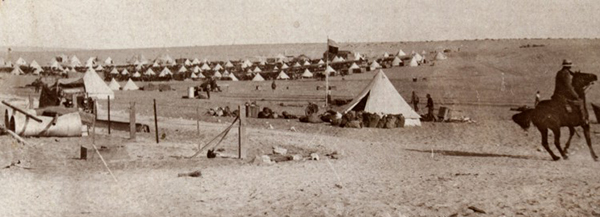 Mounted Rifles camp, location unknown. The pipes at left might be for the pipelinetransporting water across the Sinai Desert to the front line.Accession No. 1986.1136, Kippenberger Military Archive, National Army Museum Te Mata Toa, Waiouru.
Mounted Rifles camp, location unknown. The pipes at left might be for the pipelinetransporting water across the Sinai Desert to the front line.Accession No. 1986.1136, Kippenberger Military Archive, National Army Museum Te Mata Toa, Waiouru.
The Anzac Mounted Division occupied the area around Romani from late April 1916, with minor skirmishes and intelligence missions characterising their first few months. However, as the railway was built and the occupying forces grew to include British troops, attacks became more frequent. By late July, there was no doubt that a battle was coming.
That battle came on the night of 3-4 August 1916 as the combined German and Ottoman force launched an attack on Romani from Katia. The Australians first engaged with enemy fire but before dawn on 4 August they were forced to retreat. At daylight, the Australians were reinforced by more troops, including the NZMR. The Anzac Mounted Division drove the opposing forces toward the sand banks and within range of the troops defending Romani and the railway. The Turkish advance was checked and by nightfall they had been pushed back to Katia. After days of fighting, the battle ended on 12 August after the German and Ottoman force had retreated to El Arish.
Rope was appointed temporary sergeant on 1 September.



